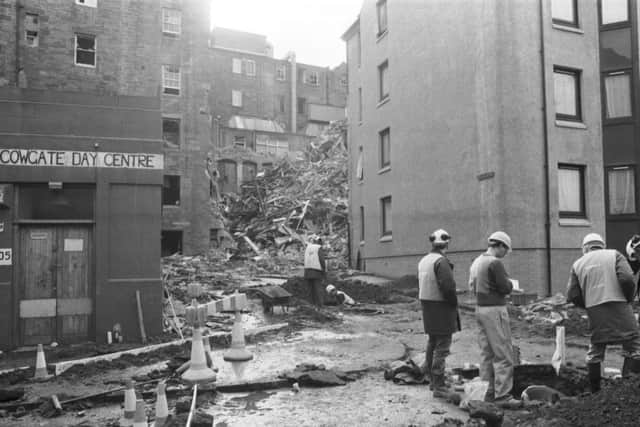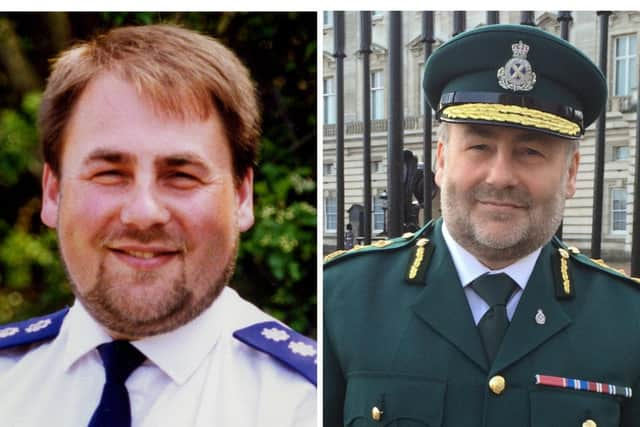Guthrie Street gas blast 30 years on: 'Bad workmanship' in laying gas pipe was to blame for explosion
and live on Freeview channel 276
An inquiry launched into the cause of the disaster found that ‘bad workmanship’ in laying a gas pipe across a sewer in the Cowgate 20 years before the incident was to blame.
Early in the morning of October 4, 1989, a cast-iron gas pipe fractured, leaking gas into sewers on the Cowgate and into the tenement at number 27 Guthrie Street.
Advertisement
Hide AdAdvertisement
Hide AdThe explosion was then detonated at 7:25am, by some kind of spark or an electrical switch being turned on in the building.


'Very Unusual Set of Circumstances'
Giving judgement at Edinburgh Sheriff Court in April 1990, Sheriff Peter McNeil found that workmen laying the pipe in 1969 failed to follow the appropriate guidelines put in place three years earlier by the Institution of Gas Engineers.
The pipe should not have been laid across a sewer chamber, as the empty space beneath increased pressure on the pipe.
“The cause of the fracture of the gas main in the Cowgate was bad workmanship in the laying of the pipe,” said the Sheriff.


Advertisement
Hide AdAdvertisement
Hide Ad“However, once the main had been laid and covered it was not possible to know that the defect was there,” he added.
The procurator fiscal later confirmed there would be no prosecution over the incident.
British Gas Scotland said it ‘accepted’ the Sheriff’s ruling, but put the leak down to a ‘very unusual set of circumstances’.
Many survivors settled claims with the company out of court, including Martin Baptie.
“The amount we got back was pretty paltry,” he said.
Advertisement
Hide AdAdvertisement
Hide Ad“British Gas did quite well to minimise the payouts. There weren’t the same kind of litigation procedures then as there are now.”
However, Mr Baptie said he is ‘not in the least bit bitter’ over the settlement.
“It’s pointless thinking about who was to blame,” said Bob Cairns, colleague and friend of Peter Small, who died in the blast.
“The old Victorian infrastructure was was past its use by date.”
Advertisement
Hide AdAdvertisement
Hide AdIn the years after the Guthrie Street incident, British Gas Scotland replaced the gas mains in several areas of Edinburgh.
“I don’t know if it had anything to do with what happened in Guthrie Street,” added Mr Cairns, “but every time I saw a road closed because they were replacing the gas mains I thought of Peter.”
Rescue led to Safety Changes for Paramedics and Firefighters
The explosion also had an effect on the operation of Scottish emergency services.
Advertisement
Hide AdAdvertisement
Hide AdMike Herriot, District Ambulance Officer for West Lothian, was the first paramedic to assess survivor Martin Baptie from the bed where he had been buried alive under a pile of rubble.
Mr Herriot had to go into the debris still wearing his officer’s uniform of a suit and tie, which was ‘clearly inappropriate’ and led to changes in requirements for safety clothing of paramedics.
The blast was also one of a number of incidents which led to the creation of a Special Operations Response team, tasked with urban search and rescue operations in similar situations.
Once created, this team was equipped with a new technology: the thermal imaging which Colin Foster had used in its rudimentary form when he arrived on the scene.
Advertisement
Hide AdAdvertisement
Hide Ad“Lots of changes were made over the years to allow medical treatment to be given in those kinds of environments,” said Mr Herriot.
The incident also led to changes in the operations of the Fire Service.
“Search and Rescue become more important after that,” said Steve Torrie, an officer in the Command and Control centre at the time.
The use of thermal imaging technology showed a new way forward for the organisation.
Advertisement
Hide AdAdvertisement
Hide Ad“It also proved the technology and showed it had value. The Fire Service spent more on technology after that,” added Mr Torrie.
Colin Foster, a member of the Fire Service Search and Rescue team who used a pioneering handheld thermal imaging device to search for survivors, said the technology made a huge difference to the search.
“We would have been searching all over the place without out it, but it allowed us to zero in our search and focus on a tiny area,” he said.